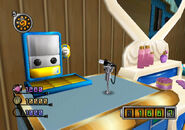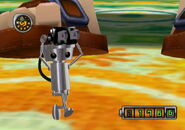- Not what you were looking for? See: Chibi-Robo (disambiguation)
Chibi-Robo! Plug Into Adventure! is the first game in the Chibi-Robo! series, and was first released for the Nintendo GameCube in Japan in 2005. It was developed by Skip Ltd. and published by Nintendo. It became a part of the New Play Control! series in Japan for Wii on June 11, 2009. The main objective of the game is to earn Happy Points by making people happy, and eventually become the best Chibi-Robo.
Story[]
The game is set in the house of a dysfunctional family, the Sandersons.
On Jenny Sanderson's eighth birthday, her father, George Sanderson, purchases her a Chibi-Robo, a small robot whose goal is to bring happiness to everyone. Because of the family's financial problems and Mr. Sanderson not having a job, Mrs. Sanderson (his wife) gets angry at Mr. Sanderson for spending so much money during such a time.
Even though the family is in a critical financial situation, they celebrate Jenny's birthday with Chibi-Robo and Telly Vision. Night eventually comes and the family goes to sleep (Mr. Sanderson being forced to sleep on the couch as Mrs. Sanderson is still mad at him), while Chibi-Robo goes off to explore the house. He and Telly Vision soon find out that all the toys around the house can move and talk. Chibi-Robo befriends them and starts helping the toys out with their troubles. His adventure around the Sandersons' house continues. Eventually, Chibi-Robo finds a large robot in the basement with a missing leg called Giga-Robo, who was once a companion of the Sandersons, but had to be deactivated due to its high electricity consumption. Chibi-Robo attempts to revive Giga-Robo by fully charging its massive battery using the Giga-charger and makes it a goal to find Giga-Robo's missing leg, but is attacked by spider-like robots called Spydorz.
When George purchases yet another toy, Helen locks herself in her room and tells him that she wants a divorce, prompting the rest of the family to do housework in an attempt to make up for it. Meanwhile, Chibi-Robo finds a strange pattern in the backyard and uses his radar to contact an alien species. Once the aliens land and greet him, Chibi-Robo uses a time machine made by the visitors to go into the past to find a code to enter a safe in the master bedroom containing Giga-Robo's leg. He returns to the present to open the safe, but several larger Spydorz are released and capture the Sandersons. It's revealed that George originally created the Spydorz to be friends with the Chibi-Robos, but his toy company reprogrammed them to be hostile (it is unknown why), causing George to quit his job. George upgrades Chibi-Robo's blaster weapon, allowing the small robot to defeat the Queen Spydor, recover Giga-Robo's missing leg, and rescue the Sandersons. George apologizes for lying to Helen, and the two reconcile. Once Chibi-Robo fully recharges Giga-Robo's battery, reattaches his missing leg, and finds the passcode needed to turn him on, he reactivates Giga-Robo, and the aliens meet them in the backyard. The aliens explain that the toys are able to walk and talk due to a request from Giga-Robo to give them life and to give all Giga-Robos infinite battery power to prevent their energy consumption. The aliens could not do the latter at the time and returned to their own planet to obtain the item necessary to grant Giga-Robo's wish. They then give Giga-Robo this ability, who shares it with Chibi-Robo and the rest of the robots in the world as well, eliminating the energy problem.
Characters[]
- Chibi-Robo: A robot produced by Citrusoft Robotics, programmed with the goal of making people happy.
- Space Hunter Drake Redcrest: A hero from a very famous TV show. Mr. Sanderson is one of his many fans and has everything related to him, like a Mug and a Toothbrush, both of which Chibi-Robo will use as Tools.
- Sophie: Tao's chew toy, who has a crush on Drake Redcrest and loves to watch his patrols.
- Free Rangers: An army of egg soldiers.
- Sarge: The leader of the Free Rangers.
- Captain Plankbeard: An old pirate who wanders around the Basement and asks Chibi-Robo for several things in order to be able to sail again (like recovering his ship or hiring a pirate crew, for example).
- The Great Peekoe: A strange toy who likes to meditate and "purify souls" (a gambling mini-game that can be used to make much Moolah in little time).
- Sunshine: A bear starving for nectar.
- Princess Pitts: A lovely princess living in Jenny's bedroom.
- Mort: A mummy living under Jenny's bed with a crush on Princess Pitts.
- Dinah: A dinosaur made of bricks with a crush on Funky Phil.
- Funky Phil: Another toy, who loves to dance and ends up with a bunch of sprouts who dance with him.
- Primopuel: A toy in a Treasure Chest.
- The Sandersons Family:
- Jenny: The eight-year-old daughter who wears a Frog Costume all day and thinks she is a Frog.
- Mr. Sanderson: The unemployed father of the family. He quits his company without telling Mrs. Sanderson, which makes her mad at him, especially since he keeps buying new Drake Redcrest toys without telling her.
- Mrs. Sanderson: After discovering her husband's resignation, she eventually ends up locking herself in her bedroom and threatens him with a divorce.
- Tao: The dog of the family, also interacts with Chibi-Robo.
- Kid Eggplant
- Mr. Prongs
- A Bird
- Two Frogs
- The Tamagotchi
- The Fish (Chibi-Robo, however, only interacts with the goldfish by feeding them with Cookie Crumbs.)
- Telly Vision: Chibi-Robo's manager, a small TV-shaped robot who offers support to Chibi-Robo, most of the time by talking in his place whenever Chibi-Robo is unable to speak. His dream is to become a singer, already having a song, "Teriyaki Blues".
- Giga-Robo: A giant robot deactivated in the Basement. He shares a close relationship with all the other Toys, but due to an energy crisis, he was deactivated.
- Spydorz: The evil spider robots designed by Mr. Sanderson and reprogrammed by his company in order to be hostile and evil to Chibi-Robos everywhere. Chibi-Robo uses his Chibi-Blaster to destroy them and used their Scrap to build Utilibots in the Recyclotron in order to help him reach otherwise impossible to reach spots or move around the house faster.
- Queen Spydor: The titular queen of the Spydorz, who is soon destroyed by Chibi-Robo with the help of Mr. Sanderson, who upgrades his Chibi-Blaster.
Development[]
- Main article: Chibi-Robo! (Prototype Pre-Alpha)
Chibi-Robo! was announced in early 2003 with publishing rights held by Bandai. Its original projected release date was June 2003 in Japan and spring 2004 in North America.[1] Unlike the released version of Chibi-Robo!, the beta version entailed the player training Chibi-Robo to defend the home of his inventor from a pair of burglars. The gameplay was different as well. Instead of a platform-adventure game, it played like a point-and-click adventure title, where the player was not in direct control of Chibi-Robo, but was rather conveying commands to him by clicking a cursor around the area.[2]
Demos[]
The game has a kiosk demo, available in the US in Interactive Multi-Game Demo Disc - Version 34, and in Europe in Interactive Multi-Game Demo Disc - April 2006. The two demos are very similar, with the only notable difference being that Telly has additional dialog in the European version. There does not appear to be a Japanese demo. In this demo, you play as Chibi-Robo limited to the Living Room and Chibi-House near the beginning of the story. The data for this demo appears to mostly be a stripped-down version of the final game.
Data from these demos exists in the final US and European versions of the game: stage 28 is the demo's Chibi-House, and stage 29 is the demo's Living Room. The US versions of these rooms are very unfinished, being modified copies of slightly earlier localizations of these rooms. They do not make a functional demo, and the game crashes trying to access these rooms at certain points. This may indicate that the US demo was not finished until after the final US version of the game was completed.
The European demo, on the other hand, exists completely intact in the European version of the game. It can be accessed by falling into the drain with the following Gecko Code active:
2026644C 0000000B
0426644C 0000001D
E2000001 80008000
Sequels[]
It received a sequel in 2007 (2008 in Australia) called Chibi-Robo! Park Patrol. In 2009, a third installment was released only in Japan, titled Okaeri! Chibi-Robo! Happy Richie Ōsōji!, which takes place in the house of a grown-up Jenny from the first game.
Gallery[]
Videos[]
Images[]

|
To view Chibi-Robo! Plug Into Adventure!'s image gallery click here
|
Trivia[]
- The game was originally going to be published by Bandai as a point & click adventure game.
- At the start of development (presumably 2002), the game's eventual director, Kenichi Nishi, was not part of the project.
- In 2003, Nintendo producer Kensuke Tanabe discussed the game with Nintendo's Shigeru Miyamoto, and Miyamoto said "The character is pretty nice, so I think if Nishi works on the game it will be great." This led to Nintendo publishing the game instead of Bandai, and Nishi taking the duty of director.
- Chibi-Robo is made from recycled aluminum. This was revealed in the second game, Chibi-Robo! Park Patrol.
- Some of the characters show graphical glitches when shot by the Chibi-Blaster.
- The flag on the trophy in the basement behind the Great Peekoe is only one dimensional. If you go behind the trophy, you can't see the flag.
References[]
- ↑ http://cube.ign.com/articles/394/394043p1.html IGN Staff (April 17, 2003). "Chibi Robo - GameCube Preview". IGN. Retrieved May 26, 2008.
- ↑ https://www.nintendo.co.jp/nom/0507/2_2/ Nintendo staff. プラグをかついで プレイレポート (in Japanese). Nintendo. Retrieved March 26, 2011.
| ||||||||||||||||||||||
]]




















